The Cambridge History of Japan, Vol. 3: Medieval Japan
Подождите немного. Документ загружается.


THE DEVELOPMENT OF ZEN MONASTICISM 609
several men have alternately held the same post. This is unpardonable. . . .
They must choose and appoint men who will hold a post for half
a
year. Those
who hold an office for less than half
a
year will not have their names entered
on the roster.
33
The same problem is raised even more acutely in the regulations of
1376:
Concerning the period of service for both ranks in recent years, we hear that
there are those who serve for only three or five days, or even change posts
three and five times in one day. This is not the Zen church that Hyakujo
intended. The previous rank must not be recognized. . . . The Shogun will
also not issue an order of appointment to such priests.
34
The abbot's choice and behavior was particularly important to effec-
tive monastic leadership, administration, and order. Even the bakufu
recognized that "the rise and fall of temples depends on the abbot."
Abbots were expected to serve for at least three years. Many, however,
retired "after only four or five months" (Article 98) or less.
35
The
installation expenses for a new abbot were a heavy drain on a monas-
tery. The bakufu's regulations repeatedly stressed that gift giving and
entertainment at such installation ceremonies should be kept to a
minimum: "Installation ceremonies must not be extravagant. Temples
are ruined primarily by such expenses, and therefore they are to be
specially prohibited. Abbots must also completely cease gift-giving
because of the great expense involved."
36
High office in one of the gozan monasteries brought distinction to
a monk, his family, and patrons. Clearly, many monks wanted the
title of abbot or senior administrator but not the obligations that
went with the office. Finding and maintaining talented monastic
leadership thus remained a critical problem for the gozan institution
and its secular sponsors. And the problem was compounded by the
fact that the shogunate collected a fee each time it issued a certificate
of appointment to an abbot. The fee varied from five kanmon for
installation as abbot of a shozan-rank monastery to fifty kanmon for
installation at the Nanzenji. This represented a substantial income
from the whole gozan system. During the fifteenth century, the
bakufu undermined its own regulations by indiscriminately issuing
such certificates of appointment (kumon) as a means of maximizing
income from the gozan.
Another, area of grave concern to warrior rulers and Zen monastic
administrators in their regulation of the gozan institution was that
33 Ibid., p. 55. 34 Ibid., p. 77. 35 Ibid., p. 65. 36 Ibid., p. 77.
Cambridge Histories Online © Cambridge University Press, 2008
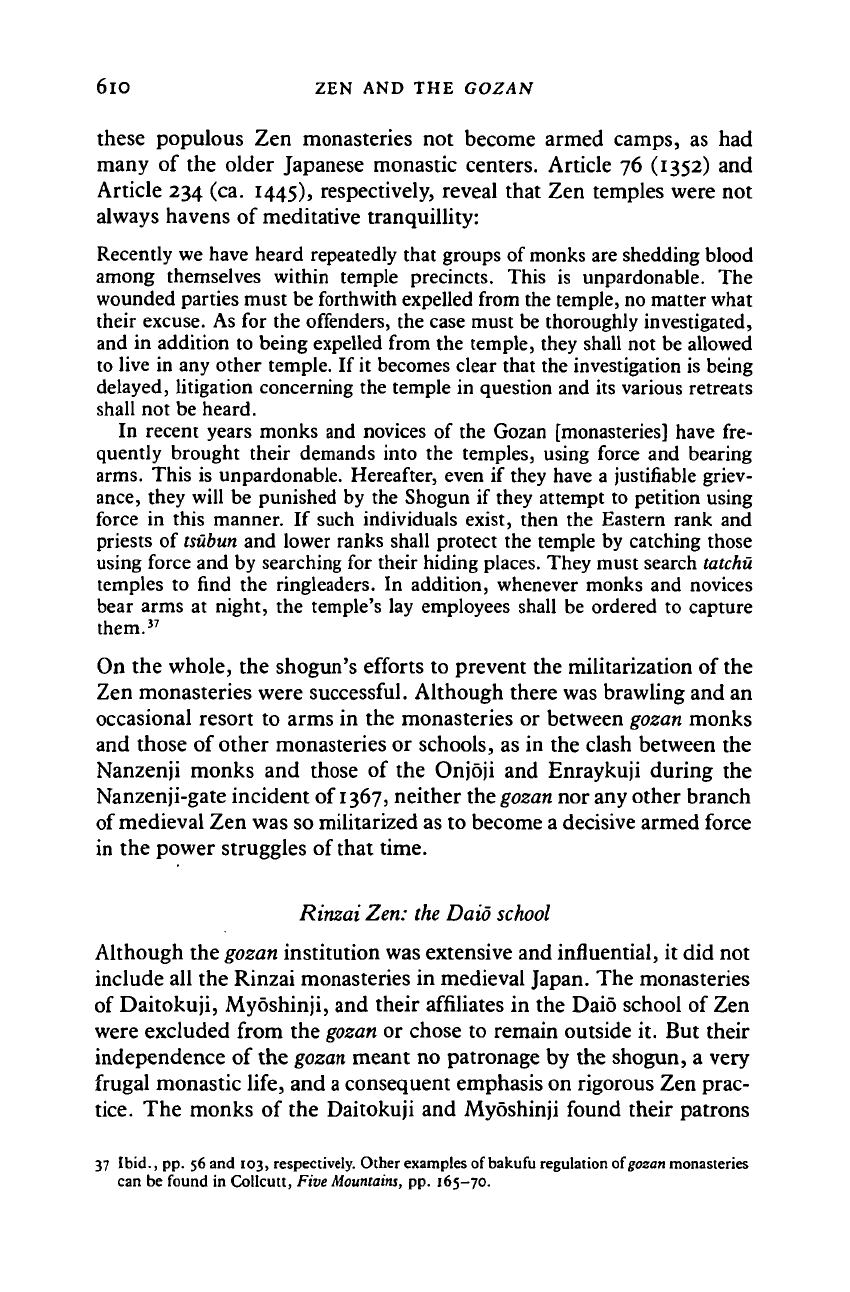
6lO ZEN AND THE GOZAN
these populous Zen monasteries not become armed camps, as had
many of the older Japanese monastic centers. Article 76 (1352) and
Article 234 (ca. 1445), respectively, reveal that Zen temples were not
always havens of meditative tranquillity:
Recently we have heard repeatedly that groups of monks are shedding blood
among themselves within temple precincts. This is unpardonable. The
wounded parties must be forthwith expelled from the temple, no matter what
their excuse. As for the offenders, the case must be thoroughly investigated,
and in addition to being expelled from the temple, they shall not be allowed
to live in any other temple. If it becomes clear that the investigation is being
delayed, litigation concerning the temple in question and its various retreats
shall not be heard.
In recent years monks and novices of the Gozan [monasteries] have fre-
quently brought their demands into the temples, using force and bearing
arms.
This is unpardonable. Hereafter, even if they have a justifiable griev-
ance,
they will be punished by the Shogun if they attempt to petition using
force in this manner. If such individuals exist, then the Eastern rank and
priests of
tsubun
and lower ranks shall protect the temple by catching those
using force and by searching for their hiding places. They must search
tatchu
temples to find the ringleaders. In addition, whenever monks and novices
bear arms at night, the temple's lay employees shall be ordered to capture
them.
37
On the whole, the shogun's efforts to prevent the militarization of the
Zen monasteries were successful. Although there was brawling and an
occasional resort to arms in the monasteries or between
gozan
monks
and those of other monasteries or schools, as in the clash between the
Nanzenji monks and those of the Onjoji and Enraykuji during the
Nanzenji-gate incident of
1367,
neither the
gozan
nor any other branch
of medieval Zen was so militarized as to become a decisive armed force
in the power struggles of that time.
Rinzai Zen: the Daid
school
Although the
gozan
institution was extensive and influential, it did not
include all the Rinzai monasteries in medieval Japan. The monasteries
of Daitokuji, Myoshinji, and their affiliates in the Daio school of Zen
were excluded from the
gozan
or chose to remain outside it. But their
independence of the
gozan
meant no patronage by the shogun, a very
frugal monastic life, and
a
consequent emphasis on rigorous Zen prac-
tice.
The monks of the Daitokuji and Myoshinji found their patrons
37 Ibid., pp. 56 and 103, respectively. Other examples of bakufu regulation of gozan monasteries
can be found in CoIIcutt, Five
Mountains,
pp. 165-70.
Cambridge Histories Online © Cambridge University Press, 2008
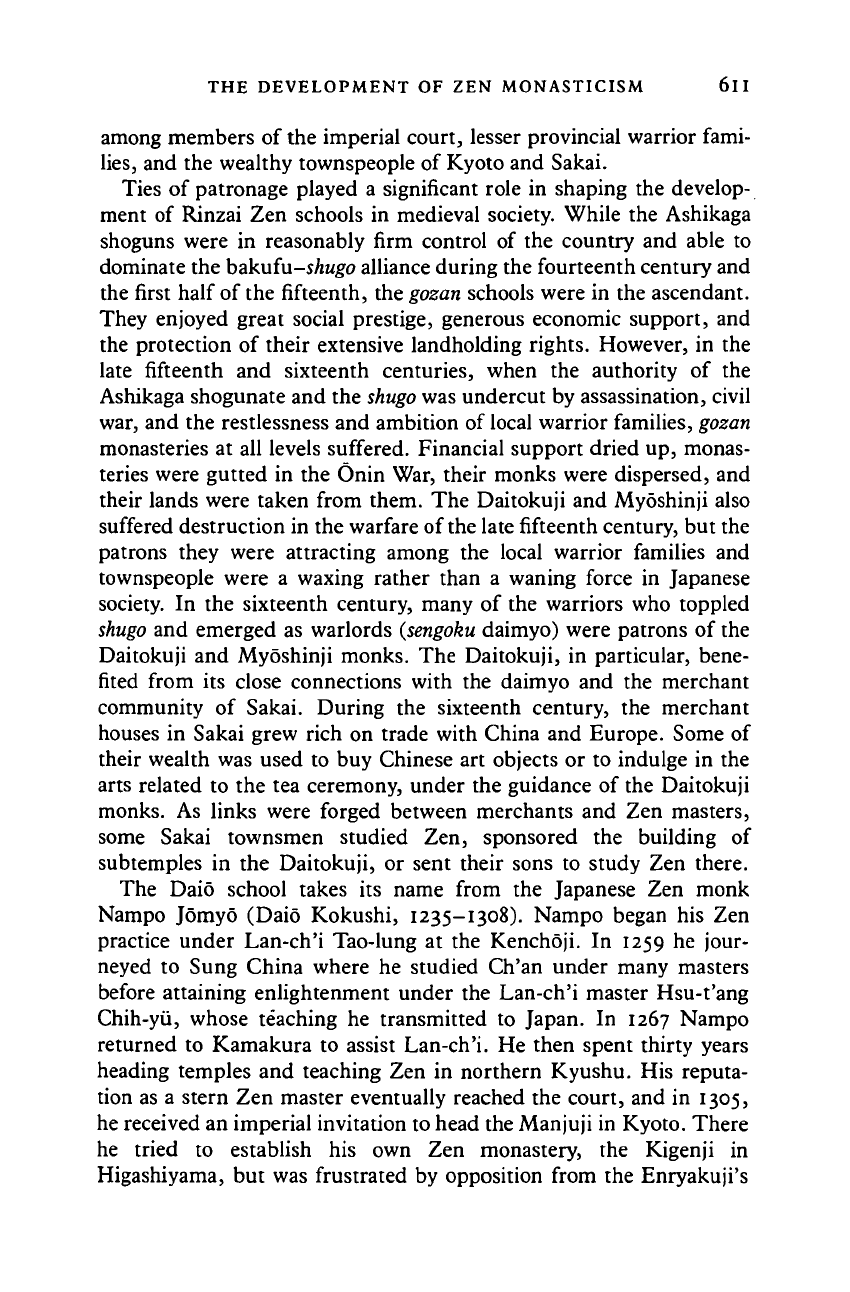
THE DEVELOPMENT OF ZEN MONASTICISM 6ll
among members of the imperial court, lesser provincial warrior fami-
lies,
and the wealthy townspeople of Kyoto and Sakai.
Ties of patronage played a significant role in shaping the develop-
ment of Rinzai Zen schools in medieval society. While the Ashikaga
shoguns were in reasonably firm control of the country and able to
dominate the bakufu-shugo alliance during the fourteenth century and
the first half of the fifteenth, the
gozan
schools were in the ascendant.
They enjoyed great social prestige, generous economic support, and
the protection of their extensive landholding rights. However, in the
late fifteenth and sixteenth centuries, when the authority of the
Ashikaga shogunate and the
shugo
was undercut by assassination, civil
war, and the restlessness and ambition of local warrior families,
gozan
monasteries at all levels suffered. Financial support dried up, monas-
teries were gutted in the Onin War, their monks were dispersed, and
their lands were taken from them. The Daitokuji and Myoshinji also
suffered destruction in the warfare of the late fifteenth century, but the
patrons they were attracting among the local warrior families and
townspeople were a waxing rather than a waning force in Japanese
society. In the sixteenth century, many of the warriors who toppled
shugo
and emerged as warlords
(sengoku
daimyo) were patrons of the
Daitokuji and Myoshinji monks. The Daitokuji, in particular, bene-
fited from its close connections with the daimyo and the merchant
community of Sakai. During the sixteenth century, the merchant
houses in Sakai grew rich on trade with China and Europe. Some of
their wealth was used to buy Chinese art objects or to indulge in the
arts related to the tea ceremony, under the guidance of the Daitokuji
monks. As links were forged between merchants and Zen masters,
some Sakai townsmen studied Zen, sponsored the building of
subtemples in the Daitokuji, or sent their sons to study Zen there.
The Daio school takes its name from the Japanese Zen monk
Nampo Jomyo (Daio Kokushi, 1235-1308). Nampo began his Zen
practice under Lan-ch'i Tao-lung at the Kenchoji. In 1259 he jour-
neyed to Sung China where he studied Ch'an under many masters
before attaining enlightenment under the Lan-ch'i master Hsu-t'ang
Chih-yii, whose teaching he transmitted to Japan. In 1267 Nampo
returned to Kamakura to assist Lan-ch'i. He then spent thirty years
heading temples and teaching Zen in northern Kyushu. His reputa-
tion as a stern Zen master eventually reached the court, and in 1305,
he received an imperial invitation to head the Manjuji in Kyoto. There
he tried to establish his own Zen monastery, the Kigenji in
Higashiyama, but was frustrated by opposition from the Enryakuji's
Cambridge Histories Online © Cambridge University Press, 2008
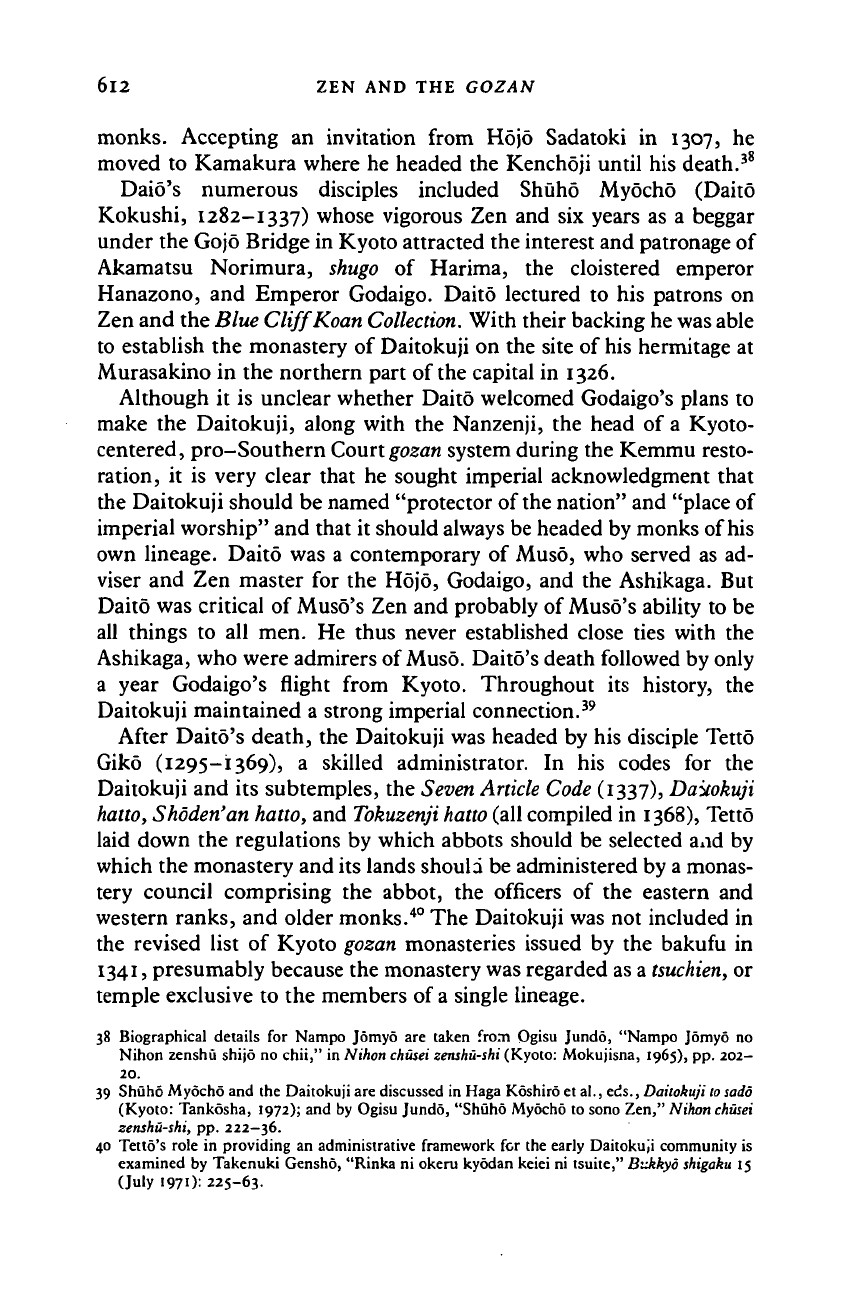
6l2 ZEN AND THE
GOZAN
monks. Accepting an invitation from Hojo Sadatoki in 1307, he
moved to Kamakura where he headed the Kenchoji until his death.
38
Daio's numerous disciples included Shuho Myochd (Daito
Kokushi, 1282-1337) whose vigorous Zen and six years as a beggar
under the Gojo Bridge in Kyoto attracted the interest and patronage of
Akamatsu Norimura, shugo of Harima, the cloistered emperor
Hanazono, and Emperor Godaigo. Daito lectured to his patrons on
Zen and the Blue Cliff
Koan
Collection.
With their backing he was able
to establish the monastery of Daitokuji on the site of his hermitage at
Murasakino in the northern part of the capital in 1326.
Although it is unclear whether Daito welcomed Godaigo's plans to
make the Daitokuji, along with the Nanzenji, the head of a Kyoto-
centered, pro-Southern Court
gozan
system during the Kemmu resto-
ration, it is very clear that he sought imperial acknowledgment that
the Daitokuji should be named "protector of the nation" and "place of
imperial worship" and that it should always be headed by monks of his
own lineage. Daito was a contemporary of Muso, who served as ad-
viser and Zen master for the Hojo, Godaigo, and the Ashikaga. But
Daito was critical of Muso's Zen and probably of Muso's ability to be
all things to all men. He thus never established close ties with the
Ashikaga, who were admirers of Muso. Daito's death followed by only
a year Godaigo's flight from Kyoto. Throughout its history, the
Daitokuji maintained a strong imperial connection.
39
After Daito's death, the Daitokuji was headed by his disciple Tetto
Giko (1295-1369), a skilled administrator. In his codes for the
Daitokuji and its subtemples, the
Seven Article Code
(1337),
Daitokuji
hatto,
Shoden'an
hatto,
and
Tokuzenji hatto
(all compiled in 1368), Tetto
laid down the regulations by which abbots should be selected and by
which the monastery and its lands should be administered by a monas-
tery council comprising the abbot, the officers of the eastern and
western ranks, and older monks.
40
The Daitokuji was not included in
the revised list of Kyoto
gozan
monasteries issued by the bakufu in
1341,
presumably because the monastery was regarded as a
tsuchien,
or
temple exclusive to the members of
a
single lineage.
38 Biographical details for Nampo Jomyo are taken from Ogisu Jundo, "Nampo Jomyo no
Nihon zenshu shijo no chii," in Nihon chusei zenshu-shi (Kyoto: Mokujisna, 1965), pp. 202-
20.
39 Shuho Myocho and the Daitokuji are discussed in Haga Koshiro et al., eds., Daitokuji
10
sado
(Kyoto: Tankosha, 1972); and by Ogisu Jundo, "Shuho Myocho to sono Zen," Nihon
chusei
zenshu-shi, pp. 222-36.
40 Tetto's role in providing an administrative framework for the early Daitokuji community is
examined by Takenuki Gensho, "Rinka ni okeru kyodan keiei ni tsuite," Bdtkyo shigaku 15
(July 1971): 225-63-
Cambridge Histories Online © Cambridge University Press, 2008
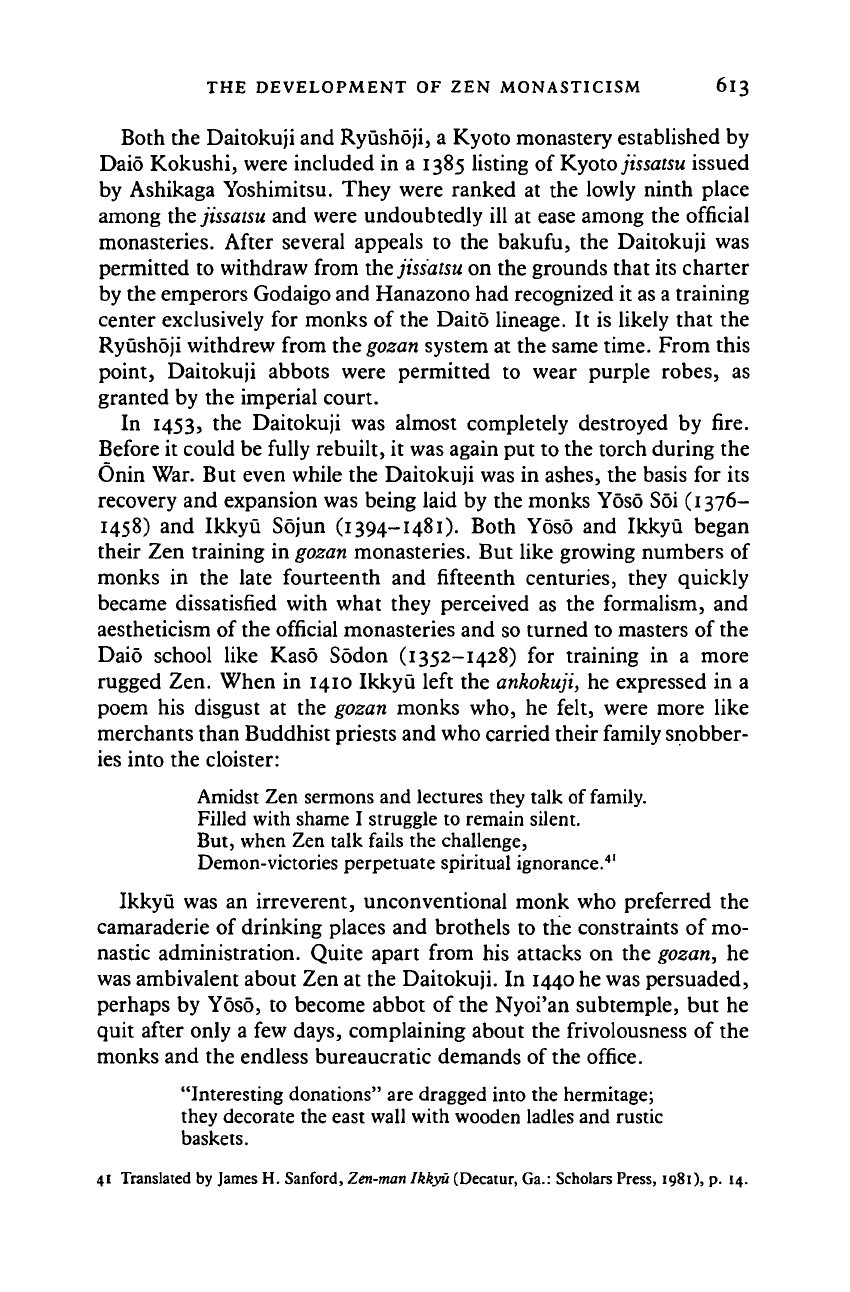
THE DEVELOPMENT OF ZEN MONASTICISM 613
Both the Daitokuji and Ryushoji, a Kyoto monastery established by
Daio Kokushi, were included in a 1385 listing of Kyoto
jissatsu
issued
by Ashikaga Yoshimitsu. They were ranked at the lowly ninth place
among the
jissatsu
and were undoubtedly ill at ease among the official
monasteries. After several appeals to the bakufu, the Daitokuji was
permitted to withdraw from the jissatsu on the grounds that its charter
by the emperors Godaigo and Hanazono had recognized it as a training
center exclusively for monks of the Dai to lineage. It is likely that the
Ryushoji withdrew from the gozan system at the same time. From this
point, Daitokuji abbots were permitted to wear purple robes, as
granted by the imperial court.
In 1453, the Daitokuji was almost completely destroyed by fire.
Before it could be fully rebuilt, it was again put to the torch during the
Onin War. But even while the Daitokuji was in ashes, the basis for its
recovery and expansion was being laid by the monks Yoso Soi (1376-
1458) and Ikkyu Sojun (1394-1481). Both Yoso and Ikkyu began
their Zen training in gozan monasteries. But like growing numbers of
monks in the late fourteenth and fifteenth centuries, they quickly
became dissatisfied with what they perceived as the formalism, and
aestheticism of the official monasteries and so turned to masters of the
Daio school like Kaso Sodon (1352-1428) for training in a more
rugged Zen. When in 1410 Ikkyu left the ankokuji, he expressed in a
poem his disgust at the gozan monks who, he felt, were more like
merchants than Buddhist priests and who carried their family snobber-
ies into the cloister:
Amidst Zen sermons and lectures they talk of family.
Filled with shame I struggle to remain silent.
But, when Zen talk fails the challenge,
Demon-victories perpetuate spiritual ignorance.
41
Ikkyu was an irreverent, unconventional monk who preferred the
camaraderie of drinking places and brothels to the constraints of mo-
nastic administration. Quite apart from his attacks on the gozan, he
was ambivalent about Zen at the Daitokuji. In 1440 he was persuaded,
perhaps by Yoso, to become abbot of the Nyoi'an subtemple, but he
quit after only a few days, complaining about the frivolousness of the
monks and the endless bureaucratic demands of the office.
"Interesting donations" are dragged into the hermitage;
they decorate the east wall with wooden ladles and rustic
baskets.
41 Translated by James H. Sanford, Zen-man Ikkyu (Decatur, Ga.: Scholars Press, 1981), p. 14.
Cambridge Histories Online © Cambridge University Press, 2008
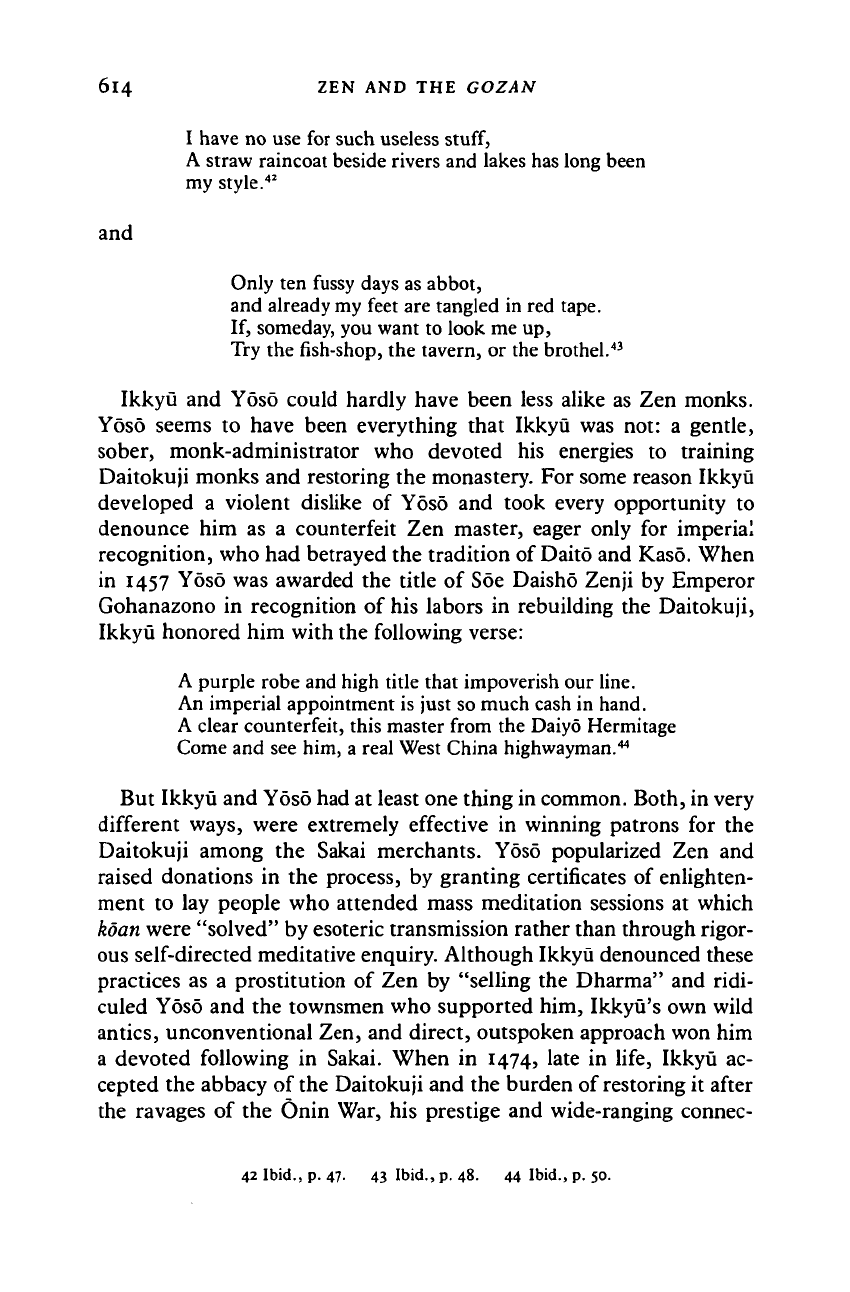
614 ZEN AND THE GOZAN
I have no use for such useless
stuff,
A straw raincoat beside rivers and lakes has long been
my style.
42
and
Only ten fussy days as abbot,
and already my feet are tangled in red tape.
If, someday, you want to look me up,
Try the fish-shop, the tavern, or the brothel.
43
Ikkyu and Yoso could hardly have been less alike as Zen monks.
Yoso seems to have been everything that Ikkyu was not: a gentle,
sober, monk-administrator who devoted his energies to training
Daitokuji monks and restoring the monastery. For some reason Ikkyu
developed a violent dislike of Yoso and took every opportunity to
denounce him as a counterfeit Zen master, eager only for imperial
recognition, who had betrayed the tradition of Daito and Kaso. When
in 1457 Yoso was awarded the title of Soe Daisho Zenji by Emperor
Gohanazono in recognition of his labors in rebuilding the Daitokuji,
Ikkyu honored him with the following verse:
A purple robe and high title that impoverish our line.
An imperial appointment is just so much cash in hand.
A clear counterfeit, this master from the Daiyo Hermitage
Come and see him, a real West China highwayman.
44
But Ikkyu and Yoso had at least one thing in common. Both, in very
different ways, were extremely effective in winning patrons for the
Daitokuji among the Sakai merchants. Yoso popularized Zen and
raised donations in the process, by granting certificates of enlighten-
ment to lay people who attended mass meditation sessions at which
koan were "solved" by esoteric transmission rather than through rigor-
ous self-directed meditative enquiry. Although Ikkyu denounced these
practices as a prostitution of Zen by "selling the Dharma" and ridi-
culed Yoso and the townsmen who supported him, Ikkyu's own wild
antics,
unconventional Zen, and direct, outspoken approach won him
a devoted following in Sakai. When in 1474, late in life, Ikkyu ac-
cepted the abbacy of the Daitokuji and the burden of restoring it after
the ravages of the Onin War, his prestige and wide-ranging connec-
42 Ibid., p. 47. 43 Ibid., p. 48. 44 Ibid., p. 50.
Cambridge Histories Online © Cambridge University Press, 2008

THE DEVELOPMENT OF ZEN MONASTICISM 615
tions attracted donations from Sakai merchants, tea masters,
renga
masters, and daimyo.
45
The links between the Daitokuji and Sakai that had been forged by
Yoso Soi and Ikkyu in the mid-fifteenth century were strengthened as
Sakai prospered in the sixteenth, by the townspeople's passion for
Chinese luxury items, Zen, and the tea ceremony. The Daitokuji's
branch temples were established in Sakai; Daitokuji prelates were
frequent visitors to the city; and in time, some of the younger sons of
the merchant families enrolled as monks in the Daitokuji or its
subtemples. After the fire of 1453, a Sakai merchant with the Bud-
dhist name of Sokan, a patron of
Yoso,
paid for the rebuilding of the
Dharma hall (hatto). Some twenty years later, the merchant Owa
Shiroraemon Sorin, a disciple of Ikkyu, bore most of the cost of re-
building the abbot's building, the Buddha hall, the Dharma hall, and
several of the older
tatchu
after their destruction in the Onin War. He
also persuaded other Sakai merchants to contribute to the establish-
ment of the Shinju'an as a memorial temple for Ikkyu and bequeathed
mortuary funds
(shidosen)
to be used as capital for moneylending ven-
tures by the Daitokuji. The documents recording the many small
"incense donations" for the thirteenth and thirty-third-year memorial
services for Ikkyu held at the Shinju'an in 1494 and 1514 include the
names of many Sakai and Kyoto merchants, as well as warriors and
wealthy peasants.
46
Whereas the backing of Sakai merchants helped the Daitokuji re-
cover from the effects of the Onin War in the late fifteenth century, it
was the patronage of the daimyo that ensured its prosperity and ush-
ered in its golden age in the sixteenth century. Before 1500, the
Daitokuji had seven subtemples. Between 1500 and 1812, another
eighteen were established, most of them by
sengoku
daimyo or by
Toyotomi Hideyoshi. Many of
these
daimyo
tatchu
combined the char-
acter of the daimyo family temple
(bodaiji)
with that of the memorial
temple
(tatchu)
for a revered Zen master and were generously sup-
ported, at least while their warrior patrons were successful in the wars
and political intrigues. The daimyo patrons shared with the Daitokuji
monks and Sakai merchants a common passion for the tea ceremony,
as well as an interest in Zen, and many
tatchu
assumed the character of
cultural salons.
Here I need mention only a few examples to convey the character of
45 Izumi Choichi, "Sakai chonin to Zen," Rekishi koron, no. 10 (1977):
89-91.
46 Hayashiya Tatsusaburo et al., Kyoto no rekishi (Kyoto: Gakugei shorin, 1968), vol. 3, pp.
128-9.
Cambridge Histories Online © Cambridge University Press, 2008

6l6 ZEN AND THE
GOZAN
daimyo patronage in the growth of the Daitokuji school.
47
The
Korin'in, for instance, was built and patronized by the Hatakeyama of
Noto and later patronized by the Maeda of Kaga. In 1597,
Hatakeyama Yoshimoto bestowed on the subtemple holdings in two
villages in Noto, producing an annual tax income of 100
kanmon.
The
Korin'in also preserved a list of those secular patrons granted Bud-
dhist names
(homyo)
between 1525 and 1535. This
hdmyochd
lists sixty-
four males and thirty-six females, mostly from Kyoto, its environs,
and Hokuriku. The fact that, apart from the Hatakeyama, most were
the deputies (hikan) of daimyo, merchants and artisans, or wealthy
peasants indicates something about the Daitokuji monks' social influ-
ence.
Obai'in was built by Kobayakawa Takakage (1533-85), one of
Hideyoshi's leading generals, and granted an annual income of one
hundred koku. Subsequently, the Obai'in came under the patronage of
the Mori (Choshu), who were related to the Kobayakawa, and during
the Tokugawa period the head monks of the Obai'in were treated as if
they were members of the Mori family. Finally, the Koto'in in was
built in 1602 by Hosokawa Tadaoki (1563-1645) as a memorial to his
famous father Hosokawa Yusai (15 34-1610).
Tadaoki's career was one of the success stories of the age. His wife,
the Christian convert Gracia, was the daughter of Akechi Mitsuhide
(1528-82). Tadaoki refused to help Mitsuhide assassinate Oda
Nobunaga and later served Hideyoshi and Ieyasu with distinction. For
his services at the battle of Sekigahara and in the Osaka campaigns,
Tadaoki was awarded the Kokura
han
(390,000
koku)
as a
fief.
Like his
father, Yusai, Tadaoki combined literary with martial skills. He was an
accomplished painter and waka poet, one of the leading students of
the tea master Rikyu, and the compiler of a guide to the conduct of the
tea ceremony, the
Hosokawa
Sansai
chaso.
Gyokuho Joso, the monk
for whom the Koto'in was built, was Yusai's younger brother.
Sengoku
daimyo did not limit their patronage to Kyoto. Many daimyo, like the
Hojo of Odawara, invited Daitokuji monks to their domains and built
provincial branch temples for them. With this kind of backing, the
Daitokuji school of Zen spread rapidly throughout Japan in the six-
teenth century. By the late sixteenth century, the Daitokuji had more
than two hundred branch temples, many of them former members of
the
gozan
hierarchy.
A third group of sponsors who contributed in the sixteenth century
47 Further information on these and other Daitokuji
taichu
can be found in Kawakami Mitsugu,
Zen'in no kenckiku (Kyoto: Kawara shot
en,
1968), pp. 127-265.
Cambridge Histories Online © Cambridge University Press, 2008
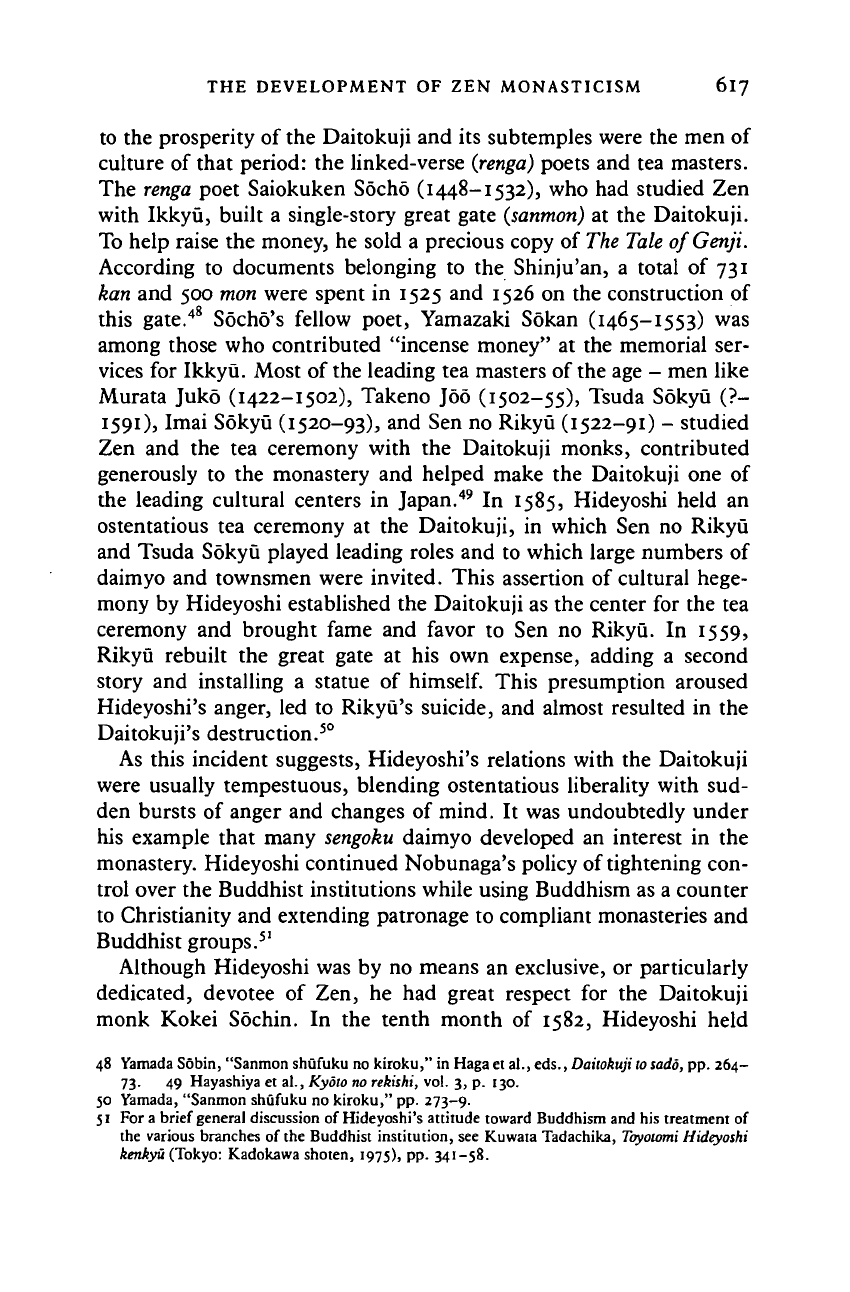
THE DEVELOPMENT OF ZEN MONASTICISM 617
to the prosperity of the Daitokuji and its subtemples were the men of
culture of that period: the linked-verse (renga) poets and tea masters.
The renga poet Saiokuken Socho (1448-1532), who had studied Zen
with Ikkyu, built a single-story great gate (sanmon) at the Daitokuji.
To help raise the money, he sold a precious copy of The Tale ofGenji.
According to documents belonging to the Shinju'an, a total of 731
kan and 500 mon were spent in 1525 and 1526 on the construction of
this gate.
48
Socho's fellow poet, Yamazaki Sokan (1465-1553) was
among those who contributed "incense money" at the memorial ser-
vices for Ikkyu. Most of the leading tea masters of the age - men like
Murata Juko (1422-1502), Takeno J66 (1502-55), Tsuda Sokyu (?-
1591),
Imai Sokyu (1520-93), and Sen no Rikyu (1522-91) - studied
Zen and the tea ceremony with the Daitokuji monks, contributed
generously to the monastery and helped make the Daitokuji one of
the leading cultural centers in Japan.
49
In 1585, Hideyoshi held an
ostentatious tea ceremony at the Daitokuji, in which Sen no Rikyu
and Tsuda Sokyu played leading roles and to which large numbers of
daimyo and townsmen were invited. This assertion of cultural hege-
mony by Hideyoshi established the Daitokuji as the center for the tea
ceremony and brought fame and favor to Sen no Rikyu. In 1559,
Rikyu rebuilt the great gate at his own expense, adding a second
story and installing a statue of
himself.
This presumption aroused
Hideyoshi's anger, led to Rikyu's suicide, and almost resulted in the
Daitokuji's destruction.
50
As this incident suggests, Hideyoshi's relations with the Daitokuji
were usually tempestuous, blending ostentatious liberality with sud-
den bursts of anger and changes of mind. It was undoubtedly under
his example that many sengoku daimyo developed an interest in the
monastery. Hideyoshi continued Nobunaga's policy of tightening con-
trol over the Buddhist institutions while using Buddhism as a counter
to Christianity and extending patronage to compliant monasteries and
Buddhist groups.
51
Although Hideyoshi was by no means an exclusive, or particularly
dedicated, devotee of Zen, he had great respect for the Daitokuji
monk Kokei Sochin. In the tenth month of 1582, Hideyoshi held
48 Yamada Sobin, "Sanmon shufuku no kiroku," in Haga et al., eds., Daiiokuji tosado, pp. 264-
73.
49 Hayashiya et al., Kyoto no rekishi, vol. 3, p. 130.
50 Yamada, "Sanmon shufuku no kiroku," pp. 273-9.
51 For a brief general discussion of Hideyoshi's attitude toward Buddhism and his treatment of
the various branches of the Buddhist institution, see Kuwata Tadachika,
Toyotomi
Hideyoshi
kenkyu (Tokyo: Kadokawa shoten, 1975), pp. 341-58.
Cambridge Histories Online © Cambridge University Press, 2008
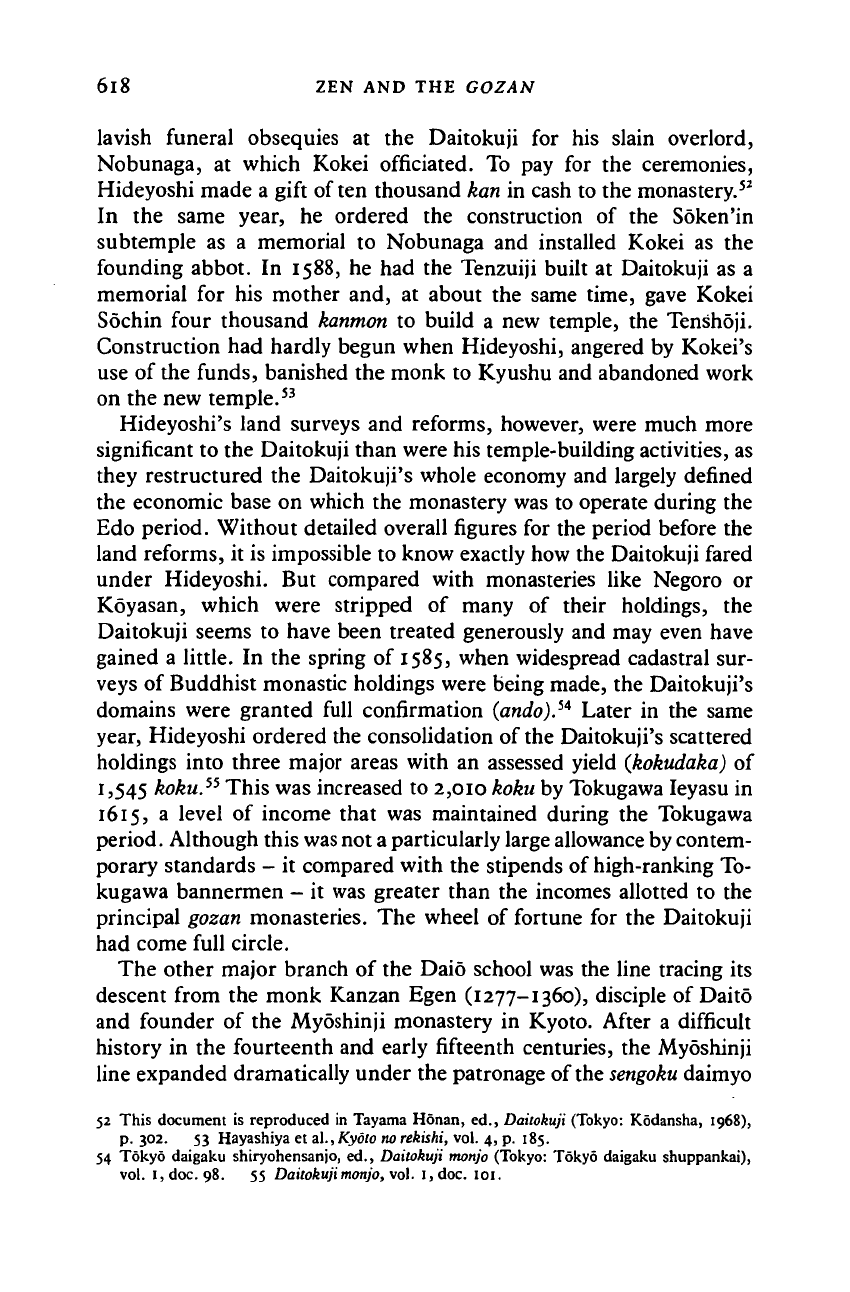
6l8 ZEN AND THE
GOZAN
lavish funeral obsequies at the Daitokuji for his slain overlord,
Nobunaga, at which Kokei officiated. To pay for the ceremonies,
Hideyoshi made a gift often thousand kan in cash to the monastery.
52
In the same year, he ordered the construction of the Soken'in
subtemple as a memorial to Nobunaga and installed Kokei as the
founding abbot. In 1588, he had the Tenzuiji built at Daitokuji as a
memorial for his mother and, at about the same time, gave Kokei
Sochin four thousand
kanmon
to build a new temple, the Tenshoji.
Construction had hardly begun when Hideyoshi, angered by Kokei's
use of the funds, banished the monk to Kyushu and abandoned work
on the new temple.
53
Hideyoshi's land surveys and reforms, however, were much more
significant to the Daitokuji than were his temple-building activities, as
they restructured the Daitokuji's whole economy and largely defined
the economic base on which the monastery was to operate during the
Edo period. Without detailed overall figures for the period before the
land reforms, it is impossible to know exactly how the Daitokuji fared
under Hideyoshi. But compared with monasteries like Negoro or
Koyasan, which were stripped of many of their holdings, the
Daitokuji seems to have been treated generously and may even have
gained a little. In the spring of 1585, when widespread cadastral sur-
veys of Buddhist monastic holdings were being made, the Daitokuji's
domains were granted full confirmation (ando).
54
Later in the same
year, Hideyoshi ordered the consolidation of the Daitokuji's scattered
holdings into three major areas with an assessed yield
(kokudaka)
of
1,545 koku.
55
This was increased to 2,010
koku
by Tokugawa Ieyasu in
1615,
a level of income that was maintained during the Tokugawa
period. Although this
was
not
a
particularly large allowance by contem-
porary standards - it compared with the stipends of high-ranking To-
kugawa bannermen - it was greater than the incomes allotted to the
principal gozan monasteries. The wheel of fortune for the Daitokuji
had come full circle.
The other major branch of the Daio school was the line tracing its
descent from the monk Kanzan Egen (1277-1360), disciple of Daito
and founder of the Myoshinji monastery in Kyoto. After a difficult
history in the fourteenth and early fifteenth centuries, the Myoshinji
line expanded dramatically under the patronage of
the sengoku
daimyo
52 This document is reproduced in Tayama Honan, ed., Daitokuji (Tokyo: Kodansha, 1968),
p.
302. 53 Hayashiya et al., Kyoto no rekishi, vol. 4, p. 185.
54 Tokyo daigaku shiryohensanjo, ed., Daitokuji monjo (Tokyo: Tokyo daigaku shuppankai),
vol.
I, doc. 98. 55 Daitokuji monjo, vol. I, doc. 101.
Cambridge Histories Online © Cambridge University Press, 2008
